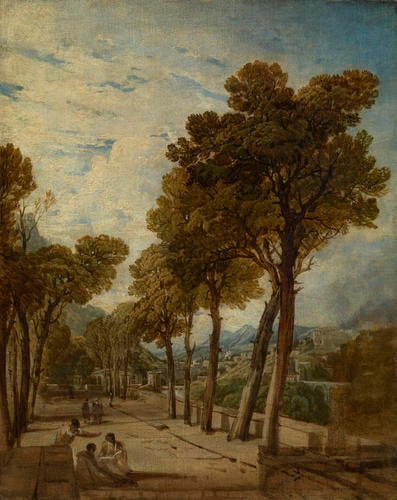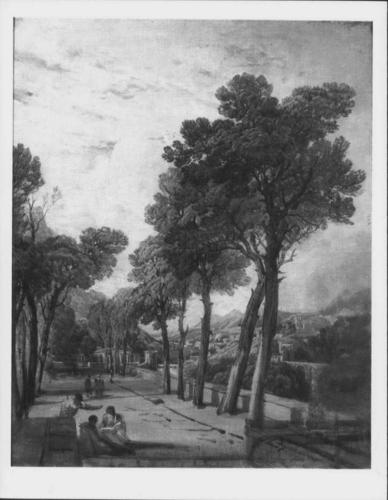-
1 of 253523 objects
An Italian Landscape
Oil on canvas | 48.6 x 38.7 cm (support, canvas/panel/stretcher external) | RCIN 405274

Sir Augustus Wall Callcott (1779-1844)
An Italian Landscape

Sir Augustus Wall Callcott (1779-1844)
An Italian Landscape


-
Callcott was originally a chorister at Westminster Abbey but abandoned a musical career in favour of painting, entering the Royal Academy Schools, London, in 1797, where he studied with the portrait painter John Hoppner. Though his first Academy exhibits were portraits, by the early 19th century he was painting landscapes. Some of his earliest compositions were topographical views in watercolour; however, he preferred to work in oil, painting ideal and picturesque landscapes. From around 1805 he developed a rustic picturesque style influenced by Dutch traditions and the work of Gainsborough. These paintings proved popular and garnered Callcott commissions from leading patrons of the period.
Callcott established a friendship with J.M.W. Turner, with whom he shared an interest in the atmospheric effects of light. In Callcott's work, this developed into the characteristic use of pale colours and vaporous effects. While his reputation initially advanced rapidly – he was elected an Associate of the Royal Academy in 1806 and a full Academician in 1810, criticism of Callcott's work by Sir George Beaumont proved damaging and his career suffered.
In 1815 Callcott moved away from the pastoral landscapes that had dominated his early output and began painting marine works with a cool tonality derived from Dutch masters including Aelbert Cuyp. Such works, with their careful execution and sober colouring well regarded as a more acceptable alternative to Turner's increasingly bold style. Callcott's later artistic production primarily consisted of smaller marine paintings and landscapes in the style of Claude, depicting Italy and the Alps, of which this is an example. He also made narrative genre paintings inspired by the work of his friends David Wilkie and William Mulready. While such works were popular with his contemporaries, they have not withstood the test of time and have obscured the more substantial achievements of his earlier years.
In 1827, Callcott married the writer and traveller Maria Graham and their Kensington home quickly became one of London's most important cultural salons. Callcott had close links with many continental artists. His interests, which included German and Italian primitives and the German Nazarenes, were to have a formative influence on younger friends, including William Dyce and Charles Lock Eastlake. He was knighted in 1837 and appointed Surveyor of the Queen's Pictures in 1843, following the death of his wife who had been on friendly terms with Queen VictoriaCallcott himself died in 1844, however, and the Queen and Prince Albert acquired this painting from his executors in 1845.
Prince Albert's Brand is on the back.Provenance
Acquired by Queen Victoria and Prince Albert in 1845
-
Creator(s)
(nationality)Acquirer(s)
-
Medium and techniques
Oil on canvas
Measurements
48.6 x 38.7 cm (support, canvas/panel/stretcher external)
58.2 x 47.5 x 1.5 cm (frame, external)
Category
Object type(s)
Subject(s)
Other number(s)
Alternative title(s)
An Eastern landscape : numerous figures on a terrace foreground